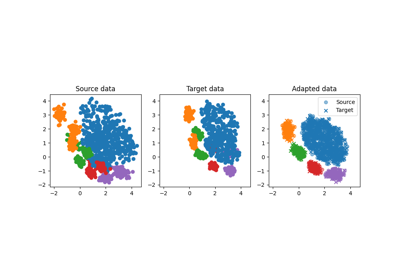skada.MultiLinearMongeAlignmentAdapter
- skada.MultiLinearMongeAlignmentAdapter(reg=1e-08, bias=True, test_time=False)[source]
Aligns multiple domains using Gaussian Monge mapping to a barycenter.
The method is a simplified extension of [29] using the Bures-Wasserstein distance and mapping of [7] to align multiple source domains to a barycenter. The sued of barycenter alignment with gaussien assumption was proposed in [30].
- Parameters:
- regfloat, optional (default=1e-08)
Regularization parameter added to the diagonal of the covariance.
- biasbool, optional (default=True)
Estimate bias.
- test_timebool, optional (default=False)
If True, the estimator can be updated at test time to map new target domains unseen during training
- Attributes:
- cov_means_sources_dict
Dictionary of covariance and mean for each source domain.
- cov_means_targets_dict
Dictionary of covariance and mean for each target domain.
- barycenter_tuple
Barycenter of the source domains (mean, cov).
- _mappings_dict
Dictionary of mappings for each domain.
References
[29]Montesuma, Eduardo Fernandes, and Fred Maurice Ngole Mboula. "Wasserstein barycenter for multi-source domain adaptation." In Proceedings of the IEEE/CVF conference on computer vision and pattern recognition, pp. 16785-16793. 2021.
[7]Flamary, R., Lounici, K., & Ferrari, A. (2019). Concentration bounds for linear monge mapping estimation and optimal transport domain adaptation. arXiv preprint arXiv:1905.10155.
[30]Gnassounou, Theo, Rémi Flamary, and Alexandre Gramfort. "Convolution Monge Mapping Normalization for learning on sleep data." Advances in Neural Information Processing Systems 36 (2024).
